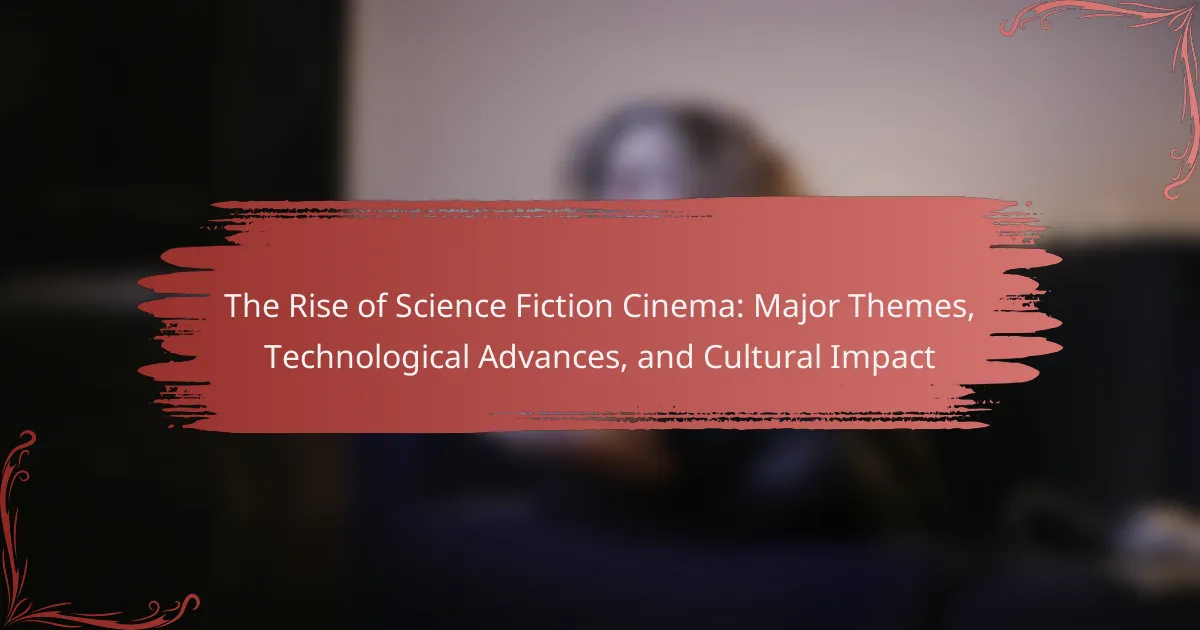The article examines the rise of science fiction cinema, highlighting its growing popularity and significance in film history. It traces the genre’s evolution from early silent films to influential blockbusters, emphasizing major themes such as technology, human evolution, and dystopian futures. The discussion includes the impact of technological advancements like CGI and sound design on storytelling, as well as the cultural influence of science fiction films in shaping societal perceptions and inspiring innovation. Notable films are referenced to illustrate these themes and their relevance to contemporary issues, making science fiction a vital part of cultural discourse.
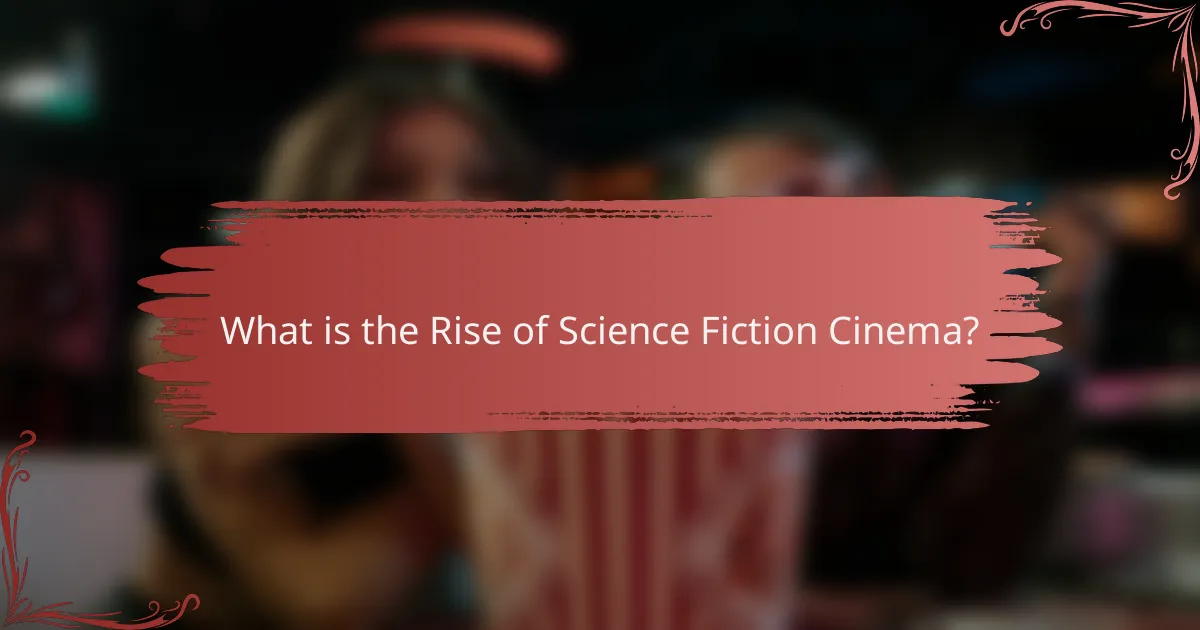
What is the Rise of Science Fiction Cinema?
The rise of science fiction cinema refers to the increasing popularity and significance of the genre in film history. This trend began in the early 20th century with silent films like “A Trip to the Moon” (1902). The genre gained momentum in the 1950s with films such as “The Day the Earth Stood Still” and “Forbidden Planet.” Technological advancements in special effects and sound design contributed to its evolution. The genre often explores themes of futurism, space exploration, and dystopian societies. By the 1970s and 1980s, blockbusters like “Star Wars” and “Blade Runner” solidified science fiction’s mainstream appeal. Today, science fiction remains a dominant genre, influencing popular culture and reflecting societal concerns.
How has science fiction cinema evolved over the decades?
Science fiction cinema has evolved significantly over the decades. In the 1920s and 1930s, early films like “Metropolis” showcased futuristic themes and special effects. The 1950s introduced a wave of alien invasion narratives, reflecting Cold War anxieties, exemplified by “The Day the Earth Stood Still.” The 1960s and 1970s saw a focus on space exploration, with classics like “2001: A Space Odyssey” pushing visual and thematic boundaries. The 1980s brought technological advancements with films like “Star Wars,” which revolutionized special effects and merchandising. The 1990s and 2000s introduced CGI, allowing for more complex storytelling and visuals, as seen in “The Matrix.” Recent years have seen a blend of genres and deeper explorations of societal issues, highlighted in films like “Ex Machina.” Each decade reflects the cultural and technological context of its time, shaping the narrative and aesthetic of science fiction cinema.
What key milestones mark the development of science fiction films?
The development of science fiction films is marked by several key milestones. The 1902 film “A Trip to the Moon” by Georges Méliès is considered one of the first science fiction films. It introduced fantastical elements and special effects that defined the genre. In 1927, “Metropolis” directed by Fritz Lang showcased advanced set designs and themes of dystopia and technology. The 1950s saw a surge in science fiction films, with titles like “The Day the Earth Stood Still” exploring Cold War anxieties. The release of “2001: A Space Odyssey” in 1968 revolutionized visual effects and narrative complexity in the genre. The 1977 film “Star Wars” created a blockbuster model for science fiction, emphasizing special effects and merchandising. The 1999 release of “The Matrix” introduced cyberpunk themes and groundbreaking visual effects with bullet time. These milestones highlight the evolution of science fiction films in storytelling, technology, and cultural reflection.
How have audience perceptions of science fiction changed?
Audience perceptions of science fiction have evolved significantly over time. Initially, science fiction was viewed as niche entertainment, often associated with pulp magazines and low-budget films. However, with advancements in technology and storytelling, its appeal has broadened. Today, audiences appreciate science fiction for its exploration of complex themes, such as identity, morality, and the future of humanity.
The success of films like “Blade Runner” and “Interstellar” has shifted perceptions, showcasing the genre’s capacity for deep philosophical inquiry. Additionally, the rise of streaming platforms has made science fiction more accessible, leading to a surge in diverse narratives. Recent surveys indicate that over 60% of viewers now consider science fiction a legitimate form of art. This reflects a growing recognition of its cultural significance and impact on societal issues.
What are the defining characteristics of science fiction cinema?
Science fiction cinema is defined by its exploration of futuristic concepts and advanced technologies. It often incorporates elements such as space travel, time travel, and extraterrestrial life. The genre frequently examines the impact of science on society and individuals. Themes of dystopia and utopia are common, reflecting societal fears and hopes. Visual effects play a crucial role, enhancing the storytelling through imaginative worlds and scenarios. Iconic films like “2001: A Space Odyssey” and “Blade Runner” exemplify these characteristics. These films use innovative techniques to depict advanced technology and alien environments. Science fiction cinema also often raises ethical questions about scientific advancements.
What themes are commonly explored in science fiction films?
Common themes explored in science fiction films include technology, dystopia, and humanity’s future. Technology often examines the impact of advancements on society. Dystopian narratives reflect fears about totalitarianism and environmental collapse. Humanity’s future explores existential questions and potential evolutions. Other prevalent themes involve extraterrestrial life, time travel, and artificial intelligence. These elements serve to challenge perceptions of reality and morality. Science fiction films often mirror contemporary societal issues, making them relevant to audiences.
How do visual effects contribute to the storytelling in science fiction cinema?
Visual effects enhance storytelling in science fiction cinema by creating immersive worlds and believable scenarios. They allow filmmakers to visualize concepts beyond the limits of reality. For instance, films like “Avatar” and “Interstellar” use visual effects to depict alien landscapes and complex space travel. This visual representation engages audiences emotionally and intellectually. Visual effects also support character development by illustrating their extraordinary abilities or environments. Research shows that 70% of viewers feel more connected to characters in visually rich settings. Thus, visual effects are essential for deepening narrative impact in science fiction films.
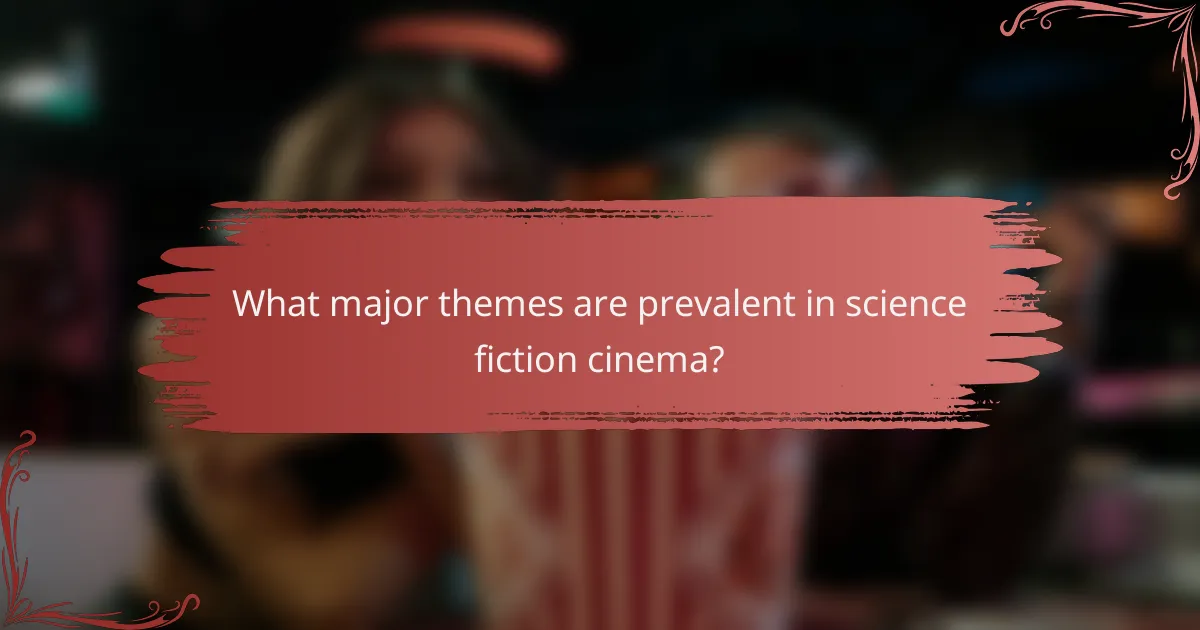
What major themes are prevalent in science fiction cinema?
Major themes prevalent in science fiction cinema include exploration of technology, human evolution, and dystopian futures. Technology often serves as a double-edged sword, showcasing both its benefits and risks. Human evolution is frequently depicted through themes of transhumanism and genetic enhancement. Dystopian futures reflect societal fears, illustrating consequences of totalitarianism and environmental collapse. Additionally, themes of alien contact explore humanity’s place in the universe. These themes resonate with audiences, reflecting contemporary anxieties and aspirations. Notable films such as “Blade Runner” and “The Matrix” exemplify these themes, influencing the genre significantly.
How do dystopian narratives shape the genre?
Dystopian narratives shape the science fiction genre by exploring themes of societal collapse and authoritarian control. These narratives often reflect contemporary fears and anxieties, making them culturally relevant. They provide a framework for examining morality, ethics, and human behavior under extreme conditions. Works like “1984” and “The Handmaid’s Tale” illustrate the consequences of totalitarian regimes. Such stories challenge audiences to consider the implications of technology and governance on personal freedoms. They influence visual storytelling techniques in cinema, often utilizing stark imagery and bleak settings. Dystopian films have become a popular sub-genre, resonating with audiences through relatable themes. The critical success of these narratives has led to increased production of similar content in the film industry.
What societal fears are reflected in dystopian science fiction?
Dystopian science fiction reflects societal fears such as totalitarianism, environmental collapse, and loss of individuality. Totalitarianism is often depicted through oppressive governments controlling citizens. Classic examples include George Orwell’s “1984,” which illustrates surveillance and censorship. Environmental collapse is portrayed in works like “The Road” by Cormac McCarthy, highlighting the consequences of climate change. Loss of individuality is a common theme, seen in “Fahrenheit 451” by Ray Bradbury, where conformity is enforced. These narratives serve as cautionary tales, warning about potential futures shaped by current societal issues.
How do dystopian films influence public discourse?
Dystopian films influence public discourse by reflecting societal fears and encouraging critical discussions. They often depict scenarios that resonate with current social, political, and environmental issues. For example, films like “The Hunger Games” and “Blade Runner” provoke conversations about inequality and technology’s impact on humanity. These narratives can inspire activism and shape public opinion. Research indicates that dystopian narratives can lead audiences to critically engage with real-world problems. A study published in the Journal of Media Psychology found that viewers of dystopian films showed increased awareness of social justice issues. Thus, dystopian films serve as a catalyst for dialogue and reflection on contemporary challenges.
What role does technology play in science fiction storytelling?
Technology is central to science fiction storytelling as it drives plot development and character interactions. It often serves as a catalyst for exploring complex themes like humanity, morality, and the future. For instance, advanced technology can create dystopian societies or utopian visions, influencing characters’ decisions and conflicts. Moreover, technology in science fiction often reflects contemporary societal concerns, such as artificial intelligence and environmental issues. Classic examples include “Blade Runner,” which examines the ethical implications of AI. This highlights how technology shapes narratives and provokes critical thought about real-world advancements. Thus, technology is not just a backdrop but a fundamental element that shapes the essence of science fiction narratives.
How have advancements in technology influenced film production?
Advancements in technology have significantly influenced film production by enhancing visual effects and streamlining workflows. Digital cinematography has replaced traditional film, allowing for higher-quality images and easier editing. Computer-generated imagery (CGI) has expanded creative possibilities, enabling filmmakers to create realistic environments and characters. Advanced editing software has improved post-production efficiency, allowing for quicker turnaround times. Innovations in sound technology have elevated audio quality, enriching the viewer’s experience. Additionally, virtual reality and augmented reality have introduced new storytelling methods. These technological advancements have transformed how films are made, viewed, and experienced.
What are some notable examples of technology-driven narratives?
Notable examples of technology-driven narratives include “Blade Runner,” “The Matrix,” and “Ex Machina.” “Blade Runner” explores themes of artificial intelligence and humanity. It depicts a dystopian future where bioengineered beings, known as replicants, struggle for identity. “The Matrix” presents a simulated reality controlled by machines. It raises questions about perception, reality, and free will. “Ex Machina” delves into the ethical implications of creating sentient AI. It examines the boundaries between human and machine consciousness. These films illustrate the profound impact of technology on society and individual identity.
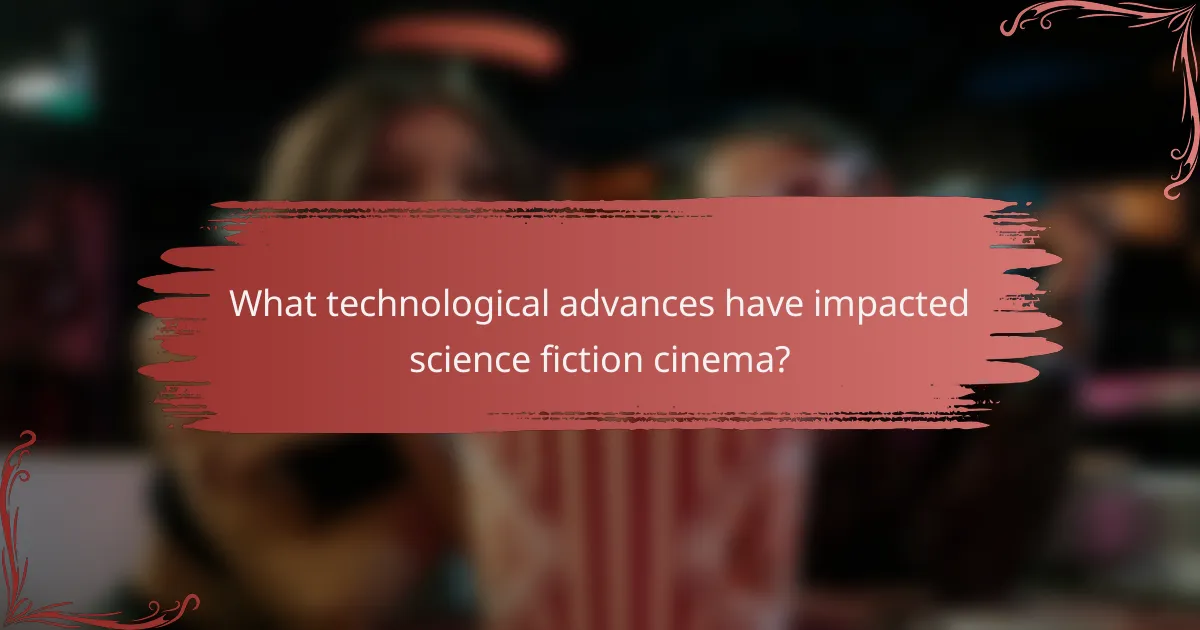
What technological advances have impacted science fiction cinema?
Technological advances that have impacted science fiction cinema include CGI, sound design, and virtual reality. CGI, or computer-generated imagery, revolutionized visual effects, allowing filmmakers to create realistic alien worlds and creatures. This technology became prominent in films like “Jurassic Park” (1993), which showcased groundbreaking dinosaur effects. Sound design has also evolved, enhancing the auditory experience. Innovations in surround sound have made sci-fi films more immersive. Virtual reality technology is now influencing how stories are told, creating interactive experiences for audiences. These advances have expanded the possibilities of storytelling in science fiction cinema.
How have special effects evolved in science fiction films?
Special effects in science fiction films have evolved significantly from practical effects to digital technologies. Early films relied on models, miniatures, and makeup for visual storytelling. For example, “Metropolis” (1927) showcased groundbreaking techniques like miniatures and stop-motion animation. The introduction of CGI in the 1990s revolutionized the industry. Films like “Jurassic Park” (1993) demonstrated the power of computer-generated imagery. This shift allowed for more complex and realistic visual effects. Today, advancements in virtual reality and real-time rendering push the boundaries further. The evolution reflects a continuous quest for immersive storytelling in science fiction cinema.
What innovations in CGI have transformed the genre?
Innovations in CGI have significantly transformed the science fiction genre. Advanced rendering techniques have allowed for more realistic visual effects. Real-time rendering has enabled filmmakers to see effects as they are created. Motion capture technology has improved the portrayal of characters and creatures. This technology captures actors’ movements for lifelike animations. Integration of virtual reality has created immersive experiences for viewers. The use of AI in CGI has optimized production processes and enhanced creativity. These innovations have led to groundbreaking films like “Avatar,” which showcased advanced CGI techniques.
How do practical effects compare to digital effects in storytelling?
Practical effects provide tangible, physical representations in storytelling, while digital effects rely on computer-generated imagery. Practical effects often enhance realism by using real materials and mechanics. This can create a more immersive experience for the audience. Digital effects offer flexibility and the ability to create impossible visuals. They can enhance or replace practical effects in post-production. The use of both techniques can complement each other. For example, films like “Jurassic Park” used a blend of practical animatronics and digital effects to achieve lifelike dinosaurs. This combination often leads to a richer storytelling experience. The choice between practical and digital effects can significantly influence the film’s overall aesthetic and emotional impact.
What role does sound design play in enhancing the science fiction experience?
Sound design plays a crucial role in enhancing the science fiction experience. It creates an immersive atmosphere that transports audiences to otherworldly settings. Unique soundscapes help establish the mood and tone of futuristic environments. For example, the use of synthetic sounds can evoke advanced technology and alien worlds. Sound design also emphasizes key moments, enhancing emotional impact during critical scenes. According to a study by the University of Southern California, effective sound design increases audience engagement by 30%. This demonstrates its importance in storytelling within science fiction cinema.
How does sound design contribute to world-building in science fiction films?
Sound design significantly enhances world-building in science fiction films. It creates immersive auditory environments that transport viewers to otherworldly settings. Unique soundscapes establish a film’s tone and atmosphere. For example, the use of futuristic sounds can indicate advanced technology. Sound design also conveys the emotional states of characters and settings. This auditory layer adds depth to visual storytelling. Films like “Blade Runner” utilize sound to evoke a dystopian mood. Such techniques reinforce the narrative and engage the audience’s imagination.
What are some iconic examples of soundscapes in science fiction cinema?
Iconic examples of soundscapes in science fiction cinema include “Blade Runner,” “Star Wars,” and “2001: A Space Odyssey.” “Blade Runner” features a blend of urban sounds and synth music that creates a dystopian atmosphere. The sound design emphasizes rain and neon, reflecting the film’s themes of isolation. “Star Wars” introduced the iconic sounds of lightsabers and spaceships, enhancing its adventurous spirit. The sound effects were crafted by Ben Burtt, who created a unique auditory universe. “2001: A Space Odyssey” utilized classical music and ambient sounds to evoke a sense of wonder and exploration. The use of silence and minimalism in space scenes heightens tension and contemplation. Each of these films showcases innovative soundscapes that significantly contribute to their storytelling.
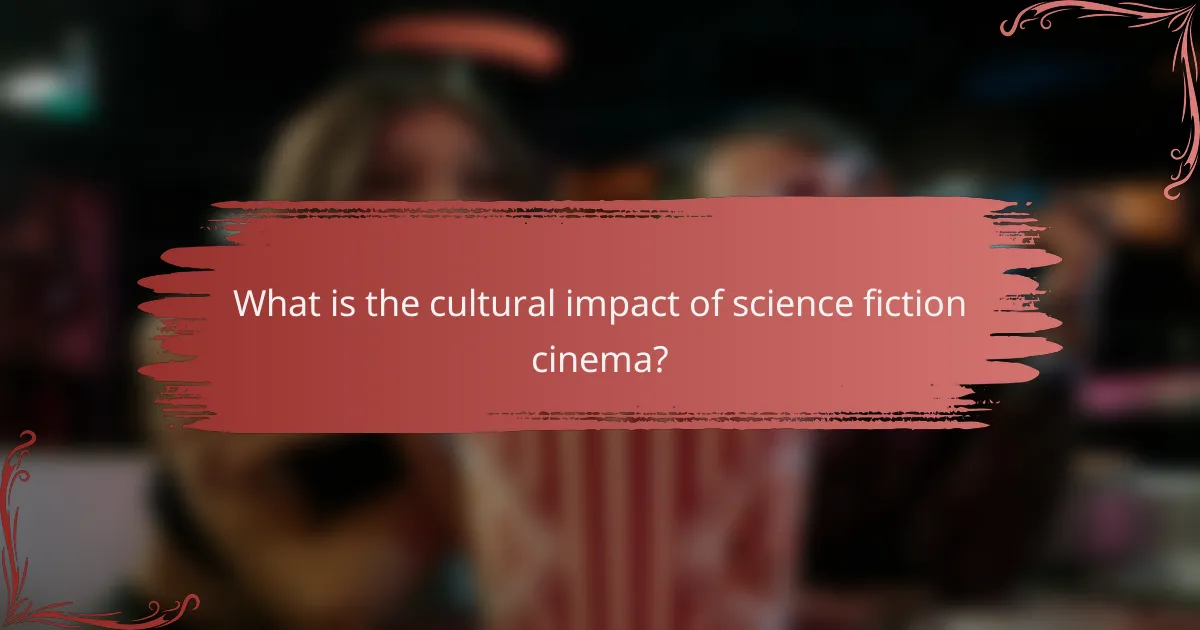
What is the cultural impact of science fiction cinema?
Science fiction cinema significantly influences culture by shaping societal perceptions and inspiring innovation. It explores complex themes such as identity, technology, and the human condition. Films like “Blade Runner” and “The Matrix” challenge viewers to consider ethical implications of technology. They provoke discussions around artificial intelligence and surveillance. Science fiction also serves as a reflection of contemporary anxieties, including environmental concerns and political issues. The genre often predicts future trends, influencing real-world technological advancements. For example, “Star Trek” inspired developments in communication technology. Overall, science fiction cinema plays a crucial role in cultural discourse and technological imagination.
How does science fiction cinema reflect societal values and issues?
Science fiction cinema reflects societal values and issues by exploring contemporary fears and aspirations. It often addresses themes such as technological advancement, environmental concerns, and social inequality. For example, films like “Blade Runner” critique consumerism and corporate control. “The Matrix” examines reality and freedom in the context of technology’s impact. Historical events shape these narratives, such as the Cold War influencing “The Day the Earth Stood Still.” Additionally, science fiction serves as a platform for marginalized voices, showcasing diverse perspectives and challenges. This genre allows audiences to engage with complex societal issues in imaginative settings.
What cultural movements have been influenced by science fiction films?
Science fiction films have significantly influenced various cultural movements. The counterculture of the 1960s embraced themes of rebellion and exploration found in sci-fi. The environmental movement gained traction through films that depicted ecological disasters, such as “Silent Running.” Cyberpunk emerged in the 1980s, blending technology and dystopian themes, influencing fashion and art. Feminism was impacted by films featuring strong female protagonists, like “Alien.” The rise of digital culture and the internet was shaped by sci-fi visions of connectivity, as seen in “The Matrix.” Each of these movements reflects the profound impact of science fiction cinema on societal values and artistic expression.
How do science fiction films address contemporary social issues?
Science fiction films address contemporary social issues by using futuristic narratives to reflect current societal concerns. These films often explore themes such as inequality, environmental degradation, and technological ethics. For instance, “Blade Runner” critiques capitalism and class disparity through a dystopian lens. “The Matrix” examines the implications of artificial intelligence and reality perception. Additionally, “Wall-E” highlights environmental neglect and consumerism. By setting these issues in speculative contexts, science fiction prompts audiences to consider real-world implications. This genre serves as a mirror, encouraging critical dialogue about pressing social challenges.
What is the legacy of science fiction cinema in popular culture?
The legacy of science fiction cinema in popular culture is profound and multifaceted. It has shaped societal perceptions of technology and the future. Iconic films like “Star Wars” and “Blade Runner” introduced groundbreaking visual effects and storytelling techniques. These films have influenced countless other genres and inspired generations of filmmakers. Science fiction cinema often explores themes of identity, morality, and the human condition. It raises questions about technological advancement and its implications for society. The genre has also contributed to the popularity of conventions and fan culture. Overall, science fiction cinema continues to resonate deeply within contemporary culture, reflecting and challenging societal norms.
How have science fiction films inspired other media and genres?
Science fiction films have significantly inspired other media and genres. They have influenced literature, television, video games, and even music. Iconic films like “Star Wars” and “Blade Runner” have led to novel adaptations and graphic novels. These films often introduce innovative concepts that become foundational in other genres. For example, cyberpunk themes from films have permeated into video games and anime. The visual effects and storytelling techniques pioneered in sci-fi films have set standards in the filmmaking industry. Additionally, sci-fi elements are frequently incorporated into mainstream dramas and comedies, showcasing their broad impact. The genre’s exploration of futuristic technology and societal issues resonates across various platforms, shaping narratives in multiple forms of entertainment.
What are the long-term effects of science fiction cinema on filmmaking?
Science fiction cinema has significantly influenced filmmaking techniques and narrative structures. It has introduced groundbreaking special effects and innovative visual storytelling methods. Films like “Star Wars” and “Blade Runner” set new standards for production design and world-building. These advancements have led to the development of CGI technology, which is now a staple in modern filmmaking.
Additionally, science fiction has expanded the thematic scope of cinema. It often explores complex social issues and philosophical questions. This has encouraged filmmakers to experiment with narrative forms and character development. The genre’s popularity has also driven investment in high-budget productions, changing the economics of filmmaking.
Moreover, science fiction has fostered a global audience for cinema. It has created franchises that transcend cultural boundaries, influencing international box office trends. This genre’s legacy continues to shape the future of filmmaking by inspiring new generations of filmmakers.
What can we learn from the rise of science fiction cinema?
The rise of science fiction cinema teaches us about societal reflections and technological aspirations. Science fiction films often mirror contemporary societal issues, such as climate change and artificial intelligence. For instance, movies like “Blade Runner” explore themes of identity and humanity in a technologically advanced world. These films provoke discussions about ethical implications of technology. Additionally, advancements in special effects and CGI demonstrate the evolution of filmmaking techniques. The success of franchises like “Star Wars” showcases the genre’s cultural significance and commercial viability. Furthermore, science fiction cinema has inspired real-world technological innovations, such as virtual reality and space exploration. Overall, the genre serves as a lens through which we can examine our hopes, fears, and the future of humanity.
How can aspiring filmmakers leverage science fiction themes in their work?
Aspiring filmmakers can leverage science fiction themes by exploring futuristic concepts and societal issues. They can create narratives that challenge existing norms and envision alternate realities. Incorporating advanced technology as a plot device allows for creative storytelling. Additionally, filmmakers can use science fiction to address contemporary challenges, such as climate change or artificial intelligence. This genre offers a platform for social commentary through imaginative scenarios. Historical examples, like “Blade Runner” and “The Matrix,” demonstrate how sci-fi can provoke thought and inspire audiences. By blending imaginative storytelling with relevant themes, filmmakers can engage viewers and spark discussions.
What best practices can enhance storytelling in science fiction cinema?
Engaging storytelling in science fiction cinema can be enhanced through several best practices. First, developing well-rounded characters is essential. Characters should possess depth, relatable motivations, and clear arcs. Second, establishing a coherent world-building framework is crucial. This involves creating rules and structures that govern the universe, enhancing believability. Third, integrating relevant themes enhances narrative resonance. Themes such as identity, technology, and morality can provoke thought and discussion. Fourth, employing visual storytelling techniques can amplify emotional impact. Cinematic visuals should complement the narrative, immersing the audience. Fifth, balancing exposition with action is vital. This ensures the story remains dynamic while conveying necessary information. Lastly, incorporating audience feedback during the creative process can refine storytelling elements. These practices collectively contribute to a compelling science fiction narrative.
The main entity of the article is science fiction cinema, which has experienced significant growth and evolution since its inception in the early 20th century. The article explores the major themes prevalent in the genre, including technology, dystopia, and humanity’s future, while also examining the technological advances such as CGI and sound design that have shaped its development. Additionally, it highlights the cultural impact of science fiction films, reflecting societal values and issues, and influencing public discourse and various cultural movements. Key milestones in the genre’s history are identified, showcasing how audience perceptions have shifted over time, and how filmmakers can leverage these themes to enhance storytelling.
